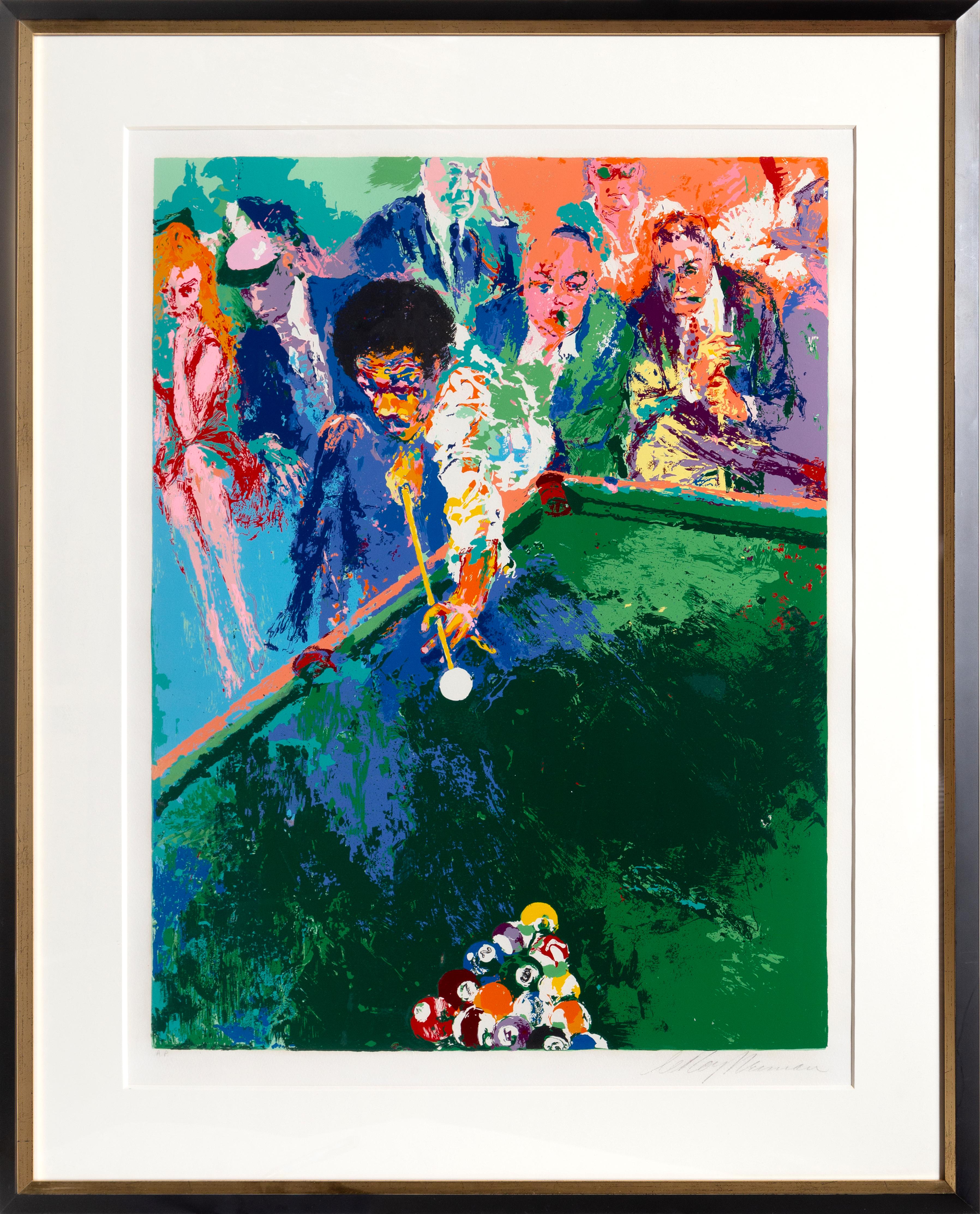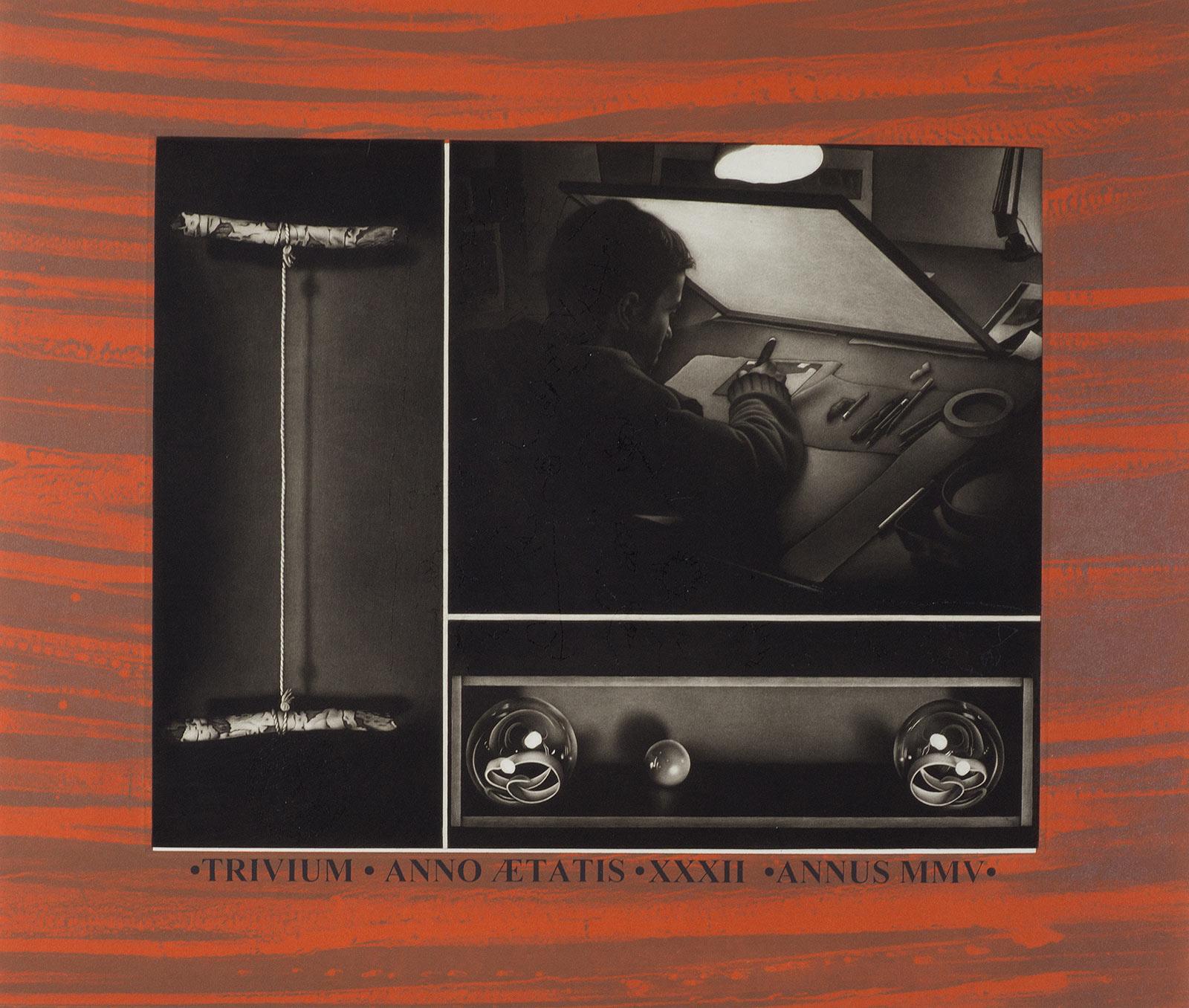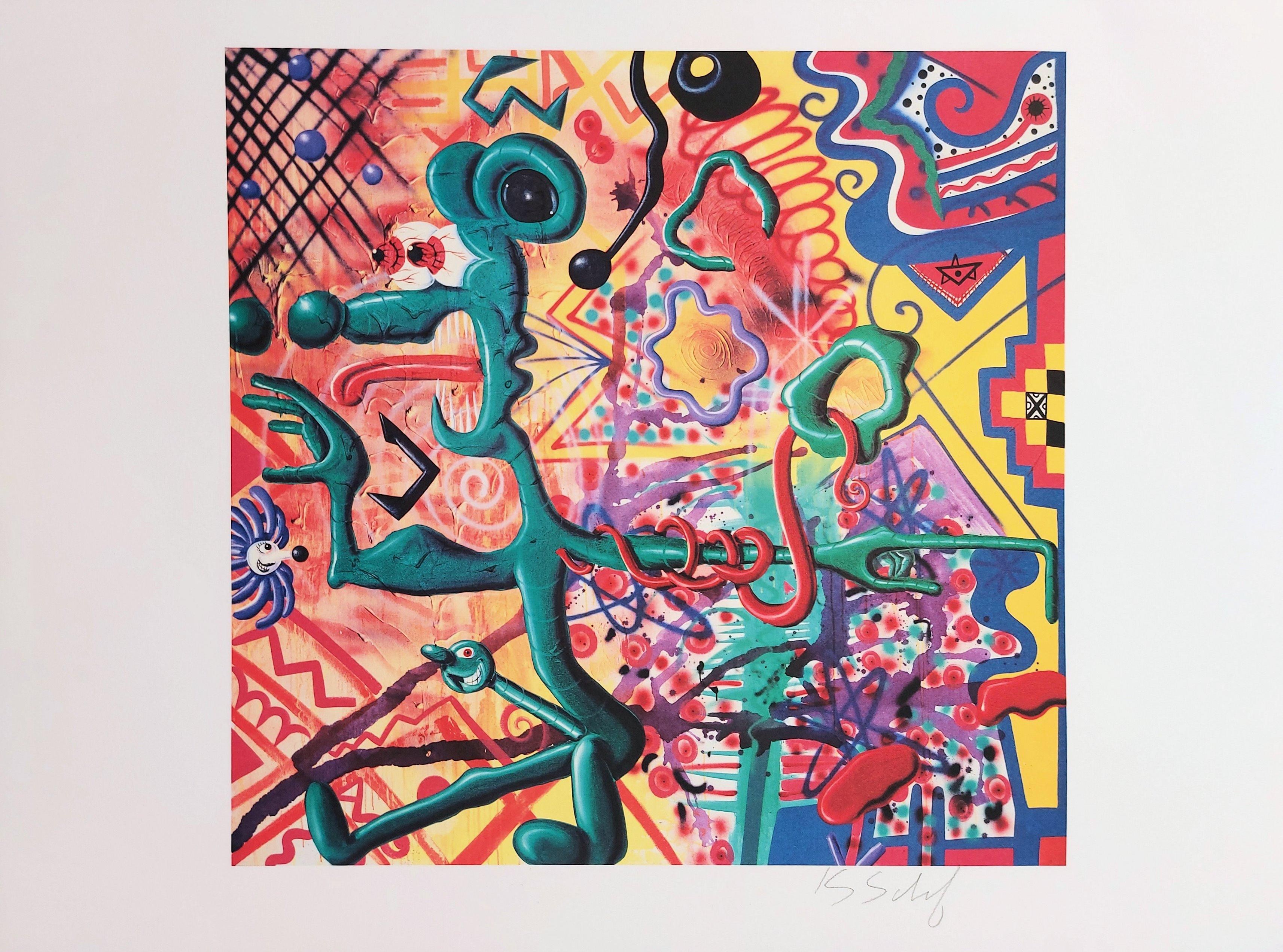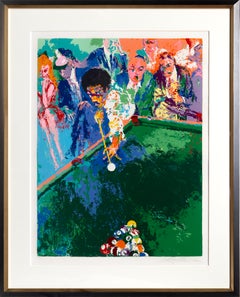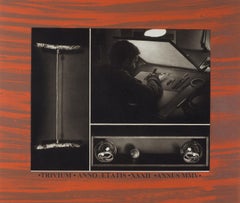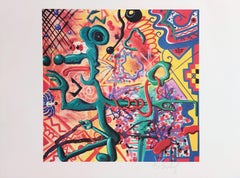Four Faces
View Similar Items
Want more images or videos?
Request additional images or videos from the seller
1 of 9
Steve LealFour Facesc.1990
c.1990
About the Item
- Creator:Steve Leal (1962)
- Creation Year:c.1990
- Dimensions:Height: 18.25 in (46.36 cm)Width: 39.25 in (99.7 cm)Depth: 0.01 in (0.26 mm)
- Medium:
- Movement & Style:
- Period:
- Condition:
- Gallery Location:San Francisco, CA
- Reference Number:Seller: leal/fou/011stDibs: LU66637336302
About the Seller
5.0
Platinum Seller
Premium sellers with a 4.7+ rating and 24-hour response times
Established in 1999
1stDibs seller since 2017
785 sales on 1stDibs
Typical response time: 2 hours
Authenticity Guarantee
In the unlikely event there’s an issue with an item’s authenticity, contact us within 1 year for a full refund. DetailsMoney-Back Guarantee
If your item is not as described, is damaged in transit, or does not arrive, contact us within 7 days for a full refund. Details24-Hour Cancellation
You have a 24-hour grace period in which to reconsider your purchase, with no questions asked.Vetted Professional Sellers
Our world-class sellers must adhere to strict standards for service and quality, maintaining the integrity of our listings.Price-Match Guarantee
If you find that a seller listed the same item for a lower price elsewhere, we’ll match it.Trusted Global Delivery
Our best-in-class carrier network provides specialized shipping options worldwide, including custom delivery.More From This Seller
View AllLa Seine a Paris, Large original color serigraph
Located in San Francisco, CA
This artwork :La Seine a Paris" c.1990 is an original color serigraph on hand made paper by American artist Linea Pergola, b.1953. It is hand signed and numbered A.P. 25/50 in pencil...
Category
Late 20th Century American Modern Figurative Prints
Materials
Screen
My Wife Married a Lie
By Kim Yoakum
Located in San Francisco, CA
This artwork titled "My Wife Married a Lie" is a original color serigraph on Wove paper by American artist Kim Yoakum. It is hand signed and numbered 51/595 in pencil by the artist. ...
Category
Late 20th Century American Modern Figurative Prints
Materials
Screen
"Elephant Family" Large original serigraph.
By LeRoy Neiman
Located in San Francisco, CA
This artwork titled "Elephant Family" 1983 is an original large color serigraph on paper by noted American artist Leroy Neiman, 1921-2012. It is hand signed and numbered 63/300 in pe...
Category
Late 20th Century American Modern Animal Prints
Materials
Screen
Circe 2
By Will Barnet
Located in San Francisco, CA
This artwork titled "Circe" 1979 is an original colors serigraph on Wove paper by noted American artist Will Barnet, 1911-2012. It is hand signed, titled and numbered 43/100 in pencil by the artist. The image size (circle) is 18 x 18 inches, sheet size is 23.25 x 24 inches. It is in excellent condition, has never been framed.
About the artist:
Born in 1911 in Beverly, Massachusetts, Barnet knew by the age of ten that he wanted to be an artist. As a student, he studied with Philip Leslie Hale at the School of the Museum of Fine Arts, Boston and viewed first-hand John Singer Sargent at work on the murals of the Boston Public Library. In 1930, Barnet studied at the Art Students League of New York, with Stuart Davis and Charles Locke, beginning his long association with the school. Here he concentrated on painting as well as printmaking, and, in 1936, he became the official printer for the Art Students League. There, he later instructed students in the graphic arts at the school and taught alongside the likes of Yasuo Kuniyoshi, Robert Beverly Hale and Richard Pousette-Dart. Barnet influenced a generation of artists, including James Rosenquist, Knox Martin, Emil Milan, Paul Jenkins, Ethel Fisher...
Category
Late 20th Century American Modern Figurative Prints
Materials
Screen
$1,800
"Metropolitan Opera, New York City Premiere" Large serigraph.
By LeRoy Neiman
Located in San Francisco, CA
This artwork titled "Metropolitan Opera, New York City, Premiere" 1980 is an original colors serigraph by noted American artist LeRoy Neiman, 1921-2012. It is hand signed and numbere...
Category
Late 20th Century American Modern Figurative Prints
Materials
Screen
Toast
Located in San Francisco, CA
This artwork titled "Toast" c.1990, is an original color serigraph by American artist Rickey Jewell Hohimer, 1946-2021. It is hand signed, titled and numbered 98/300 in pencil by the artist. The image size is 23.75 x 9.5 inches, framed size is 30.25 x 16.25 inches. The artwork is in excellent condition, the frame is slightly damaged, and will be replaced by a new similar black frame when sold. This will bring the over all condition to excellent.
About the artist:
Although formally trained with a MFA in painting, Rickey Jewell Hohimer has used the styles of Van Gogh and Gaughin to reach for the spontaneity and simplicity of today's folk art. Hohimer creates figures which are not photos of reality; they are romantically stylized to encourage straightforward emotional responses both to the colorful images and to the situations in which they find themselves. Each of Hohimer's paintings lays out a basic story line to which viewers add their own details. "I want the viewer to become personally involved. My paintings offer a change from those which encourage extensive intellectualizing about what the artist is trying to convey. I want viewers to smile -- to enjoy the whimsical nature of what they are experiencing -- to feel it, not to analyze it. His jazz paintings are stories on canvas of inspired musicians spontaneously making music of the moment. Life in the jazz age is clubs and nightlife beckoning to musicians to produce jazz art...
Category
Late 20th Century American Modern Figurative Prints
Materials
Screen
You May Also Like
Black Break, Screenprint by LeRoy Neiman
By LeRoy Neiman
Located in Long Island City, NY
Artist: LeRoy Neiman, American (1921 - 2012)
Title: Black Break
Year: 1973
Medium: Serigraph, signed and numbered in pencil
Edition: AP, 300
Size: 26 in. x 20.2 in. (66.04 cm x 51.3...
Category
1970s American Modern Figurative Prints
Materials
Screen
Trivium MMV
By Francisco Souto
Located in New Orleans, LA
In medieval universities, the trivium comprised the three subjects that were taught first: grammar, logic, and rhetoric. The word is a Latin term meaning "the three ways" or "the thr...
Category
Early 2000s American Modern Figurative Prints
Materials
Mezzotint, Lithograph, Screen
$575 Sale Price
23% Off
Ratfinkbonerthunk : Surrealist Rat - Original Giclee Print, Handsigned
By Kenny Scharf
Located in Paris, IDF
Kenny Scharf
Ratfinkbonerthunk : Surrealist Rat, 1990
Original Giclee Print
Handsigned in pencil
On Arches vellum 56 x 76 cm (c. 22 x 30 in)
Published by Editions Vermorel in 1990
...
Category
1990s American Modern Figurative Prints
Materials
Giclée, Screen
"The Capture, " Jacob Lawrence, Harlem Renaissance, Black Art, Haitian Series
By Jacob Lawrence
Located in New York, NY
Jacob Lawrence (1917 - 2000)
The Capture of Marmelade (from The Life of Toussaint L'Ouverture series), 1987
Color screenprint on Bainbridge Two Ply Rag paper
Sheet 32 1/8 x 22 1/16 inches
Sight 29 3/4 x 19 1/4 inches
A/P 1/30, aside from the edition of 120
Signed, titled, dated, inscribed "A/P" and numbered 1/30 in pencil, lower margin.
Literature: Nesbett L87-2.
A social realist, Lawrence documented the African American experience in several series devoted to Toussaint L’Ouverture, Frederick Douglass, Harriet Tubman, life in Harlem, and the civil rights movement of the 1960s. He was one of the first nationally recognized African American artists.
“If at times my productions do not express the conventionally beautiful, there is always an effort to express the universal beauty of man’s continuous struggle to lift his social position and to add dimension to his spiritual being.” — Jacob Lawrence quoted in Ellen Harkins Wheat, Jacob Lawrence: The Frederick Douglass and Harriet Tubman Series of 1938 – 40.
The most widely acclaimed African American artist of this century, and one of only several whose works are included in standard survey books on American art, Jacob Lawrence has enjoyed a successful career for more than fifty years. Lawrence’s paintings portray the lives and struggles of African Americans, and have found wide audiences due to their abstract, colorful style and universality of subject matter. By the time he was thirty years old, Lawrence had been labeled as the “foremost Negro artist,” and since that time his career has been a series of extraordinary accomplishments. Moreover, Lawrence is one of the few painters of his generation who grew up in a black community, was taught primarily by black artists, and was influenced by black people.
Lawrence was born on September 7, 1917,* in Atlantic City, New Jersey. He was the eldest child of Jacob and Rosa Lee Lawrence. The senior Lawrence worked as a railroad cook and in 1919 moved his family to Easton, Pennsylvania, where he sought work as a coal miner. Lawrence’s parents separated when he was seven, and in 1924 his mother moved her children first to Philadelphia and then to Harlem when Jacob was twelve years old. He enrolled in Public School 89 located at 135th Street and Lenox Avenue, and at the Utopia Children’s Center, a settlement house that provided an after school program in arts and crafts for Harlem children. The center was operated at that time by painter Charles Alston who immediately recognized young Lawrence’s talents.
Shortly after he began attending classes at Utopia Children’s Center, Lawrence developed an interest in drawing simple geometric patterns and making diorama type paintings from corrugated cardboard boxes. Following his graduation from P.S. 89, Lawrence enrolled in Commerce High School on West 65th Street and painted intermittently on his own. As the Depression became more acute, Lawrence’s mother lost her job and the family had to go on welfare. Lawrence dropped out of high school before his junior year to find odd jobs to help support his family. He enrolled in the Civilian Conservation Corps, a New Deal jobs program, and was sent to upstate New York. There he planted trees, drained swamps, and built dams. When Lawrence returned to Harlem he became associated with the Harlem Community Art Center directed by sculptor Augusta Savage, and began painting his earliest Harlem scenes.
Lawrence enjoyed playing pool at the Harlem Y.M.C.A., where he met “Professor” Seifert, a black, self styled lecturer and historian who had collected a large library of African and African American literature. Seifert encouraged Lawrence to visit the Schomburg Library in Harlem to read everything he could about African and African American culture. He also invited Lawrence to use his personal library, and to visit the Museum of Modern Art’s exhibition of African art in 1935.
As the Depression continued, circumstances remained financially difficult for Lawrence and his family. Through the persistence of Augusta Savage, Lawrence was assigned to an easel project with the W.P.A., and still under the influence of Seifert, Lawrence became interested in the life of Toussaint L’Ouverture, the black revolutionary and founder of the Republic of Haiti. Lawrence felt that a single painting would not depict L’Ouverture’s numerous achievements, and decided to produce a series of paintings on the general’s life. Lawrence is known primarily for his series of panels on the lives of important African Americans in history and scenes of African American life. His series of paintings include: The Life of Toussaint L’Ouverture, 1937, (forty one panels), The Life of Frederick Douglass, 1938, (forty panels), The Life of Harriet Tubman, 1939, (thirty one panels), The Migration of the Negro,1940 – 41, (sixty panels), The Life of John Brown, 1941, (twenty two panels), Harlem, 1942, (thirty panels), War, 1946 47, (fourteen panels), The South, 1947, (ten panels), Hospital, 1949 – 50, (eleven panels), Struggle: History of the American People, 1953 – 55, (thirty panels completed, sixty projected).
Lawrence’s best known series is The Migration of the Negro, executed in 1940 and 1941. The panels portray the migration of over a million African Americans from the South to industrial cities in the North between 1910 and 1940. These panels, as well as others by Lawrence, are linked together by descriptive phrases, color, and design. In November 1941 Lawrence’s Migration series was exhibited at the prestigious Downtown Gallery in New York. This show received wide acclaim, and at the age of twenty four Lawrence became the first African American artist to be represented by a downtown “mainstream” gallery. During the same month Fortune magazine published a lengthy article about Lawrence, and illustrated twenty six of the series’ sixty panels. In 1943 the Downtown Gallery exhibited Lawrence’s Harlem series, which was lauded by some critics as being even more successful than the Migration panels.
In 1937 Lawrence obtained a scholarship to the American Artists School in New York. At about the same time, he was also the recipient of a Rosenwald Grant for three consecutive years. In 1943 Lawrence joined the U.S. Coast Guard and was assigned to troop ships that sailed to Italy and India. After his discharge in 1945, Lawrence returned to painting the history of African American people. In the summer of 1947 Lawrence taught at the innovative Black Mountain College in North Carolina at the invitation of painter Josef Albers.
During the late 1940s Lawrence was the most celebrated African American painter in America. Young, gifted, and personable, Lawrence presented the image of the black artist who had truly “arrived”. Lawrence was, however, somewhat overwhelmed by his own success, and deeply concerned that some of his equally talented black artist friends had not achieved a similar success. As a consequence, Lawrence became deeply depressed, and in July 1949 voluntarily entered Hillside Hospital in Queens, New York, to receive treatment. He completed the Hospital series while at Hillside.
Following his discharge from the hospital in 1950, Lawrence resumed painting with renewed enthusiasm. In 1960 he was honored with a retrospective exhibition and monograph prepared by The American Federation of Arts. He also traveled to Africa twice during the 1960s and lived primarily in Nigeria. Lawrence taught for a number of years at the Art Students League in New York, and over the years has also served on the faculties of Brandeis University, the New School for Social Research, California State College at Hayward, the Pratt Institute, and the University of Washington, Seattle, where he is currently Professor Emeritus of Art. In 1974 the Whitney Museum of American Art in New York held a major retrospective of Lawrence’s work that toured nationally, and in December 1983 Lawrence was elected to the American Academy of Arts and Letters. The most recent retrospective of Lawrence’s paintings was organized by the Metropolitan Museum of Art in 2020, and was accompanied by a major catalogue. Lawrence met his wife Gwendolyn Knight...
Category
1970s American Modern Figurative Prints
Materials
Paper, Screen
$10,000 Sale Price
20% Off
Ressurectionem Ex-Mortuis - Original Screenprint Handsigned
By Shepard Fairey
Located in Paris, IDF
Shepard Fairey (Obey Giant)
Ressurectionem Ex-Mortuis, 2020
Screenprint
Handsigned in pencil and dated 2020 by the artist
Justified "AP" (Artist's Proof)
Size 61 x 61 cm (c. 24 x ...
Category
2010s American Modern Figurative Prints
Materials
Screen
Interlude, Screenprint by Will Barnet
By Will Barnet
Located in Long Island City, NY
Artist: Will Barnet, American (1911 - 2012)
Title: Interlude
Year: 1982
Medium: Serigraph, signed and numbered in pencil
Edition: AP
Image Size: 20 x 38 inches
Size: 25.5 x 42.5 in. (64.77 x 107.95 cm)
Fig 179, pg 70 from Will Barnet: Prints 1931-2005, published by John Szoke...
Category
1980s American Modern Figurative Prints
Materials
Screen
